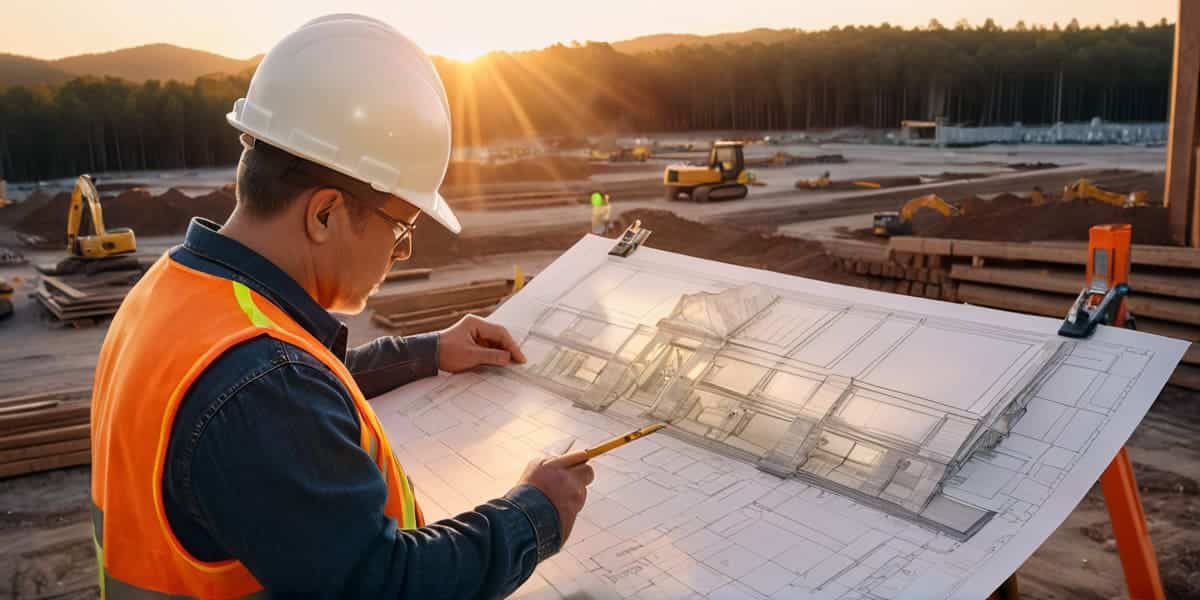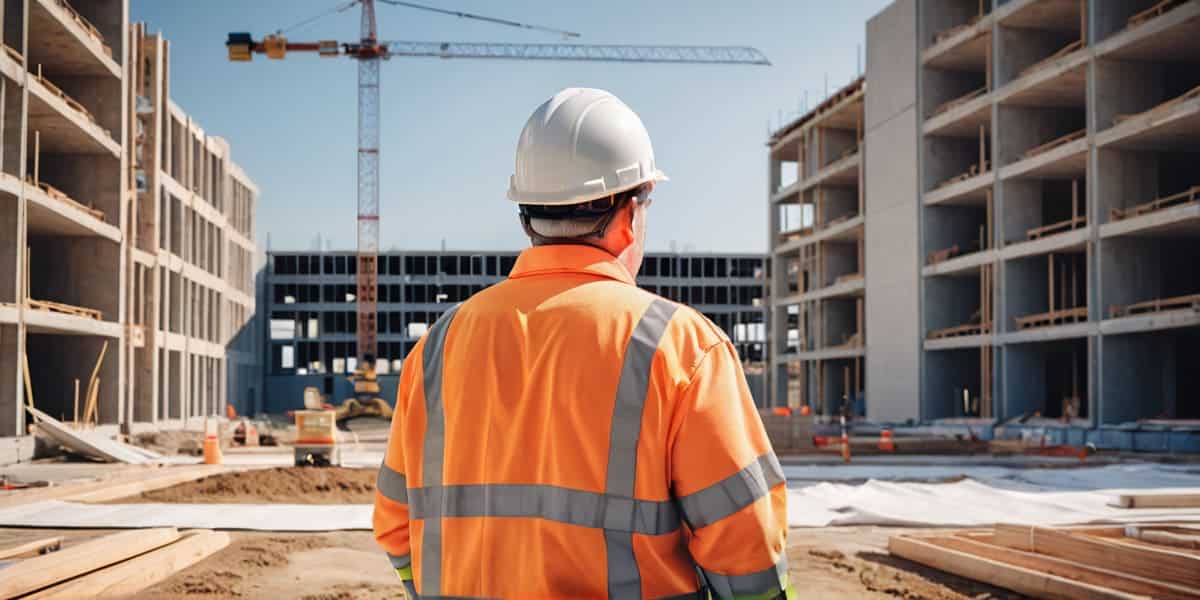 Groundworks Planning – Preparing for Large-Scale Construction
Groundworks Planning – Preparing for Large-Scale Construction

Groundworks Planning: Why Does It Matter?
Effective groundworks planning is the bedrock of successful large-scale construction projects. It sets the stage for all subsequent building activities, ensuring that the project is built on a solid foundation, both literally and figuratively.
Key Components of a Comprehensive Groundworks Plan
A comprehensive groundworks plan encompasses several critical elements:
- Site Analysis: Detailed surveys and assessments to understand the terrain and soil conditions.
- Regulatory Compliance: Ensuring all construction activities adhere to local zoning laws, building codes, and environmental regulations.
- Risk Management: Identifying potential risks early on and developing strategies to mitigate them.
- Resource Allocation: Efficiently managing labour, materials, and equipment from the outset.
Reducing Risks and Costs
Groundworks planning can significantly reduce project risks and costs by:
- Anticipating Challenges: Identifying potential issues before they become costly problems.
- Optimising Resources: Careful planning allows for the prudent use of resources, avoiding waste and unexpected expenses.
Alignment with Project Goals and Timelines
Groundworks planning aligns with overarching project goals and timelines by:
- Setting Clear Milestones: Establishing a timeline for each phase of the groundwork ensures that the project stays on track.
- Coordinating Efforts: Aligning the groundwork with the overall project plan ensures that all teams are working towards the same objectives.
By addressing these aspects, groundworks planning lays a strong foundation for construction projects, ensuring they are completed on time, within budget, and to the required standards.

Site Analysis: The Foundation of Construction
Before the first shovel hits the ground, a meticulous site analysis lays the groundwork for a successful construction project. This phase is critical, as it informs every subsequent decision, from design to execution.
Topographical Survey: Mapping the Terrain
A topographical survey provides a detailed representation of the site’s natural and manmade features. It is the first step in understanding the lay of the land, which is essential for planning the placement of structures, drainage systems, and access routes. This survey ensures that your project is built on solid groundboth literally and figuratively.
Soil and Geotechnical Investigations: Assessing Suitability
The integrity of any construction project is only as strong as the soil it rests upon. Soil and geotechnical investigations determine the ground’s bearing capacity, the presence of contaminants, and the potential for shifts or settlements. These insights guide the design of foundations and other substructures, ensuring long-term stability.
Environmental Impact Assessment: Ensuring Sustainability
An environmental impact assessment is not just a regulatory formality; it’s a cornerstone of responsible construction. It evaluates the potential effects of your project on the surrounding ecosystem, ensuring that the build is sustainable and compliant with environmental standards.
Utilities and Infrastructure Mapping: Coordinating Integration
Understanding the existing utilities and infrastructure is crucial for avoiding costly disruptions. Mapping these elements helps in planning the integration of new services and ensures that the groundwork supports the site’s current and future needs. This step is about harmonising your project with the established systems to ensure seamless functionality upon completion.
Navigating the Legal Landscape: Compliance and Permits
Understanding and adhering to the legal requirements is a pivotal step in groundworks planning. This ensures that your project proceeds without legal impediments and aligns with community standards and safety regulations.
Zoning Laws and Building Codes: The Framework for Construction
Zoning laws and building codes are the backbone of construction legality. They dictate what can be built and where, influencing the design and placement of your project. It’s essential to review these regulations early in the planning process to ensure that your groundwork aligns with municipal requirements and to avoid costly redesigns.
Environmental Regulations: Shaping Groundwork Strategies
Environmental regulations are designed to protect the ecosystem and public health. They impact groundworks planning by setting standards for waste management, pollution control, and the preservation of natural resources. Compliance with these regulations not only minimises environmental impact but also safeguards your project against legal and financial repercussions.
Health and Safety Standards: Ensuring a Secure Worksite
Health and safety standards are non-negotiable in the construction industry. They ensure the well-being of workers and the public. During groundworks, adherence to these standards is critical to prevent accidents and ensure a smooth progression to subsequent construction phases.
Permit Acquisition Process: Securing the Green Light
Acquiring the necessary permits is a multi-step process that often involves submitting detailed plans and undergoing inspections. It’s a rigorous procedure that validates that your groundwork planning meets all the required legal standards. Securing permits is a clear signal to proceed with confidence, knowing that your project complies with all regulations.

Designing the Blueprint: Project Planning and Cost Estimation
The blueprint of your project serves as the roadmap from conception to completion. It’s where every critical decision is documented, and it sets the stage for the entire construction process.
Conceptual Design’s Impact on Groundworks
The conceptual design is more than just an architect’s vision; it’s a strategic tool that shapes the groundwork phase. It influences the selection of construction methods, materials, and the overall approach to preparing the site. By aligning the design with the realities of the terrain and project objectives, you ensure that the groundworks lay a solid foundation for what’s to come.
The Role of BIM in Groundworks Planning
Building Information Modelling (BIM) technology is revolutionising groundworks planning. It allows for a collaborative and integrated approach, where every detail is modelled in 3D, ensuring that potential issues are identified and addressed before they manifest on-site. BIM enhances communication among stakeholders and streamlines the planning process, saving time and resources.
Developing and Refining Cost and Timeline Estimates
Accurate cost and timeline estimates are the bedrock of any construction project. These estimates are developed through a detailed analysis of the project scope, site conditions, and resource availability. They are continually refined as more information becomes available, ensuring that the project remains financially viable and on schedule.
Strategies for Budget Adherence
To keep the project within budget during the groundworks phase, consider the following strategies:
- Implement value engineering to identify cost-saving opportunities without compromising quality.
- Maintain a contingency reserve for unexpected site conditions or changes in scope.
- Conduct regular financial reviews to monitor expenditures and adjust plans as necessary.
By employing these strategies, you maintain control over the project’s finances, ensuring that the groundwork sets a precedent for efficiency and fiscal responsibility.
Ensuring Stability: Ground Stabilisation and Earthworks
Stability is paramount in groundworks to prevent future structural issues. Your project’s longevity depends on the techniques used to stabilise the site before construction begins.
Techniques for Site Stability and Safety
To ensure the construction site’s stability and safety, various techniques are employed:
- Excavation and Grading: These are the first steps in shaping the site, setting the stage for a stable foundation.
- Soil Stabilisation: Techniques such as soil mixing and chemical stabilisation are used to enhance soil strength and durability.
Tailoring Shoring and Underpinning Solutions
Shoring and underpinning are critical for maintaining the integrity of existing structures and the construction site. These solutions are tailored to project specifications, considering factors like soil type, load requirements, and the proximity of adjacent structures.
Soil Compaction and Ground Improvement Methods
Compaction increases soil density, reducing air gaps and enhancing load-bearing capacity. Ground improvement methods, such as vibro-compaction or geosynthetics, are used to reinforce the soil.
Implementing Erosion and Sediment Control
Erosion and sediment control measures are vital to prevent site degradation and environmental impact. Strategies include:
- Silt Fencing: To capture sediment runoff.
- Stormwater Management: To control the flow and reduce erosion potential.
- Vegetative Covers: To stabilise exposed soil.
By implementing these measures, you ensure that the groundwork phase establishes a robust foundation for the construction to follow.

Foundations and Substructures: The Bedrock of Your Project
The choice of foundation is a critical decision in the groundwork planning process, as it supports the entire weight of the construction project. Your approach to laying the groundwork will set the stage for the structural integrity and longevity of the building.
Determining the Right Foundation
When selecting a foundation for your large-scale construction project, several considerations come into play:
- Soil Type and Conditions: The bearing capacity and stability of the soil determine the suitability of foundation types.
- Load Distribution: The weight of the proposed structure dictates the foundation’s design to ensure even load distribution.
- Project Scope and Scale: Larger projects may require deeper, more robust foundations to accommodate their size and complexity.
Designing and Executing Piling and Deep Foundation Systems
Piling and deep foundation systems are designed to reach stable soil layers deep below the surface. Their execution involves:
- Site Investigation: Detailed analysis of the soil profile to determine the depth and type of piling required.
- Design Specifications: Engineering the piles to withstand the loads and environmental conditions they will face.
- Installation: Employing specialised equipment and techniques to instal the piles accurately and safely.
Best Practices for Basement Construction and Waterproofing
Basement construction and waterproofing are essential for preventing water ingress and structural damage. Best practices include:
- Waterproof Membranes: Applying robust waterproof barriers to protect against moisture.
- Drainage Systems: Installing comprehensive drainage solutions to manage groundwater effectively.
Ensuring Structural Integrity
To guarantee the load-bearing capacity and structural integrity of substructures, rigorous engineering standards are applied:
- Material Quality: Using high-grade materials that meet or exceed industry standards.
- Quality Control: Conducting regular inspections and tests throughout the construction process.
- Engineering Expertise: Leveraging the knowledge of experienced engineers to oversee the design and construction of foundational elements.
By meticulously planning and executing each step of the foundation and substructure phase, you ensure a solid base for your construction project, paving the way for a safe and durable structure.

Integrating Essential Services: Utilities and Infrastructure Planning
In the intricate dance of groundworks planning, integrating essential services such as water, drainage, and power is a pivotal step. It requires foresight, coordination, and a deep understanding of both the project’s needs and existing municipal systems.
Water, Drainage, and Sewage System Integration
The integration of water, drainage, and sewage systems into groundworks is a complex but critical process. It begins with:
- Mapping Existing Infrastructure: Identifying current water and sewage lines to plan connections and expansions.
- Designing for Efficiency: Creating systems that not only serve the immediate needs of the project but are also scalable for future development.
- Ensuring Compliance: Adhering to local codes and environmental regulations to prevent future legal and operational issues.
Electrical and Telecommunications Considerations
For electrical and telecommunications infrastructure, planning revolves around:
- Capacity Planning: Ensuring that the electrical grid can handle the added demand from the construction.
- Future-proofing: Incorporating conduits and cabling that meet today’s needs and anticipate tomorrow’s technologies.
- Coordination with Service Providers: Working closely with utility companies to align project timelines and technical requirements.
Addressing Gas and Fuel Supply
Gas and fuel supply planning involves:
- Safety Assessments: Evaluating risks and implementing safety measures for gas lines.
- Strategic Placement: Designing the layout to optimise access and maintenance while minimising disruptions.
Coordinating with Utility Providers and Municipalities
Effective coordination with utility providers and municipalities is achieved through:
- Regular Communication: Establishing clear channels for ongoing dialogue throughout the project.
- Permitting and Approvals: Navigating the permitting process with the support of local authorities.
- Synchronisation of Efforts: Aligning the groundwork schedule with utility companies’ timelines to ensure seamless service integration.
By meticulously planning for these essential services, you lay the groundwork for a construction project that is not only functional but also harmonious with the surrounding infrastructure.
Mitigating Risks: Safety and Risk Management
In groundworks planning, risk management is a proactive measure to ensure the safety and security of the construction site and its workers. A comprehensive approach to risk assessment and management is essential to identify potential hazards and implement strategies to mitigate them.
Conducting Comprehensive Risk Assessments
A thorough risk assessment is the first step in safeguarding your construction project. This involves:
- Identifying Potential Hazards: Analysing the site and project plans to pinpoint risks related to ground conditions, equipment use, and environmental factors.
- Evaluating Risks: Assessing the likelihood and potential impact of identified hazards on the project’s timeline, budget, and personnel.
- Developing Mitigation Strategies: Outlining procedures to reduce or eliminate risks, such as reinforcing unstable soil or implementing weather-related work stoppages.
Establishing Site Safety Plans and Emergency Procedures
Safety plans and emergency procedures are critical components of risk management. They include:
- Site Safety Protocols: Clear guidelines for equipment operation, personal protective equipment (PPE) use, and site access control.
- Emergency Response Plans: Detailed actions for various emergency scenarios, ensuring a swift and coordinated response to incidents.
Implementing Worker Health and Safety Training
Worker training is a non-negotiable aspect of construction safety. It encompasses:
- Regular Training Sessions: Educating workers on safety practices, hazard recognition, and emergency response.
- Certification Programmes: Ensuring workers are certified in their respective roles, particularly when operating heavy machinery or performing specialised tasks.
Quality Control Measures During Groundworks
Quality control is integral to maintaining high safety standards. This includes:
- Regular Inspections: Scheduled and random checks to ensure adherence to safety regulations and project specifications.
- Monitoring Systems: Utilising technology to track the condition of equipment and the stability of the site in real-time.
By systematically addressing each aspect of risk management, you create a secure groundwork environment that prioritises the well-being of everyone involved and the integrity of the project.

Embracing Sustainability: Environmental Protection and Practices
Sustainability in groundworks is not just a trend; it’s a commitment to future generations. Your project’s environmental stewardship can significantly impact the local ecosystem and the global environment.
Incorporating Sustainable Materials and Techniques
Incorporating sustainable materials and construction techniques into groundworks involves:
- Choosing Low-Impact Materials: Opting for recycled or locally sourced materials to minimise the carbon footprint.
- Implementing Green Construction Methods: Employing techniques that reduce soil disturbance and preserve the natural landscape.
Establishing Waste Management and Recycling Plans
Effective waste management and recycling are crucial for minimising the environmental impact of construction projects. Your plans should include:
- Sorting and Recycling On-Site: Segregating materials for recycling to reduce landfill waste.
- Partnering with Local Recycling Facilities: Ensuring that materials are processed responsibly and efficiently.
Ensuring Protection of Natural Habitats
Protecting natural habitats and biodiversity during construction is achieved through:
- Conducting Biodiversity Assessments: Identifying and planning around sensitive ecological areas.
- Creating Buffer Zones: Establishing protective perimeters around critical habitats.
Reducing Energy Consumption and Carbon Footprint
To reduce energy consumption and carbon footprint, consider:
- Using Energy-Efficient Machinery: Investing in modern equipment that consumes less fuel.
- Monitoring Energy Use: Tracking and optimising energy consumption throughout the groundworks phase.
By taking these steps, you demonstrate a commitment to environmental responsibility, setting a precedent for sustainable construction practices.
Collaborative Efforts: Stakeholder Engagement and Communication
Effective collaboration and communication are the cornerstones of successful groundworks planning. They ensure that every stakeholder, from architects to local community members, is aligned with the project’s goals and progress.
Managing Collaboration Among Construction Professionals
Collaboration among architects, engineers, and contractors is managed through:
- Regular Coordination Meetings: These sessions facilitate the exchange of ideas and progress updates, ensuring that all parties are on the same page.
- Integrated Project Delivery (IPD): This approach fosters a team-oriented environment where risks and rewards are shared, promoting unity and efficiency.
Strategies for Community Engagement
For community engagement and public consultations, strategies include:
- Public Information Sessions: Hosting meetings where community members can learn about the project and voice their concerns.
- Feedback Mechanisms: Providing channels for ongoing community input, such as online forums or suggestion boxes at the project site.
Ensuring Transparency with Reporting and Documentation
Transparency is maintained through:
- Clear Documentation: Keeping detailed records of decisions, changes, and progress.
- Accessible Reporting: Sharing regular updates with stakeholders in a format that is easy to understand and access.
Conflict Resolution and Negotiation
Conflict resolution and negotiation strategies are employed to address disagreements and maintain project momentum:
- Proactive Communication: Addressing issues early and openly to prevent escalation.
- Mediation and Facilitation: Engaging neutral third parties to help resolve disputes when necessary.
By prioritising stakeholder engagement and communication, you lay the groundwork for a collaborative project environment that is conducive to success and community support.

Harnessing Technology: Innovations in Groundworks Execution
The integration of advanced technology in groundworks planning is revolutionising the construction industry. By leveraging cutting-edge tools, construction companies can enhance accuracy, efficiency, and safety from the earliest stages of a project.
Advanced Surveying and Mapping Technologies
In the realm of groundworks planning, precision is key. Advanced surveying and mapping technologies such as 3D laser scanning and GPS mapping are now fundamental tools that provide:
- High-Resolution Site Data: Detailed and accurate representations of the site’s topography and existing structures.
- Efficient Data Collection: Rapid gathering of measurements, reducing the time spent on manual surveys.
The Role of Drones and Remote Sensing
Drones and remote sensing technologies are altering the landscape of site analysis by:
- Providing Aerial Perspectives: Offering comprehensive views of the site that are not possible from the ground.
- Monitoring Progress: Enabling real-time tracking of groundworks progress and identifying potential issues early.
Essential Construction Management Software
Construction management software is a cornerstone for modern groundworks planning, offering:
- Project Collaboration: Streamlining communication between all parties involved in the groundworks phase.
- Resource Allocation: Optimising the use of labour, materials, and equipment through meticulous planning and tracking.
Latest Innovations in Machinery and Equipment
The latest innovations in machinery and equipment for groundworks include:
- Automated and Robotic Systems: Enhancing precision and reducing the need for manual labour.
- Eco-Friendly Options: Machinery designed to reduce emissions and environmental impact.
By adopting these technological advancements, construction companies can ensure that groundworks planning is not only thorough but also forward-thinking, setting the stage for a successful build.
Transitioning Beyond Groundworks
As the groundworks phase concludes, the focus shifts to preparing for the above-ground construction. This transition is a critical juncture in the project lifecycle, requiring meticulous planning and execution to ensure a seamless handover and the commencement of the next phase.
Managing Handover Procedures and Documentation
The handover from groundworks to building construction is facilitated through:
- Comprehensive Documentation: Ensuring all groundwork activities are well-documented, including inspections, tests, and approvals.
- Clear Handover Protocols: Establishing protocols that outline the steps and responsibilities for transitioning to the next phase.
Steps for Transitioning to Above-Ground Construction
Transitioning to above-ground construction involves:
- Site Preparation: Confirming that the site is ready for the next phase, with all groundwork elements completed and inspected.
- Resource Allocation: Shifting resources, such as labour and equipment, to focus on above-ground tasks.
Conducting Final Inspections and Certifications
To ensure quality and compliance, final inspections and certifications are conducted:
- Quality Assurance Checks: Verifying that all groundworks meet the project’s quality standards.
- Regulatory Compliance: Ensuring all work complies with relevant codes and regulations.
Sharing Lessons Learned and Best Practices
The culmination of the groundworks phase offers an opportunity to reflect and improve:
- Lessons Learned Sessions: Conducting reviews to identify successes and areas for improvement.
- Best Practice Development: Compiling and sharing best practices for future groundwork planning.
By carefully managing each of these steps, you ensure that the project is well-positioned for the critical transition from groundworks to the next construction phase.



